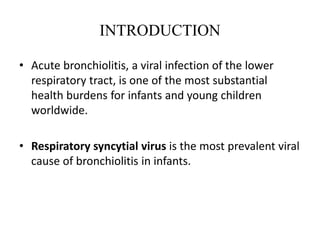This document provides information on bronchiolitis, including its risk factors, pathophysiology, microbiology, clinical presentation, diagnosis, management, prognosis, and prevention. Bronchiolitis is a common viral infection affecting the small airways of the lung in infants and young children. Respiratory syncytial virus is the most common cause. Symptoms include cough, wheezing and difficulty breathing. Management focuses on supportive care and treatment is generally self-limiting. Severe cases may require hospitalization.










































